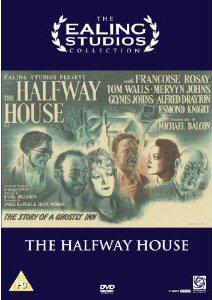
One thing I have always embraced about the Horror genre is not only the many subdivisions under its umbrella, but also how the horror film’s glittered history has evolved over the last 80 years or so. Once you exhaust Hammer you can dig deeper through time and explore Universal Studio’s glories with their monster classics. It won’t be long before you wander down the enigmatic lane of RKO and the legend that is Val Lewton. But antique British movies have a surreal charm all of their own, exemplified superbly by our very own Ealing Studios!
If you are not a horror aficionado, Ealing Studios may well conjure up memories of vintage British Comedy classics. While this is true, once the laughter stops and darkness falls, the studio produced a few notably eerie features for those of us that prefer our spines chilled as oppose to our ribs tickled...
The Halfway House, directed by Basil Dearden, is set back during WW2. The title itself refers to a quaint guest house located in the peaceful Welsh Valleys. The story begins by introducing 6 sets of characters from different parts of the Britain who, for various personal reasons, feel the need to take a break from their tribulations. There is David Davies the famous classical music conductor, whose appalling health only gives him three months to live if he doesn’t curb his punishing work schedule; William Oakley, an ex-soldier who, due to falling on hard times, has just done a stint at Her Majesties Pleasure; Captain Fortescue, an unscrupulous business man who prides himself in criminal commerce; Harry and Alice Meadows, who suffered the tragedy of losing a son to the war and are struggling with their own relationship as a result; Richard and Valerie French whose upcoming divorce is put on hold by their young daughter Johanna when she deviously manipulates them to attend the hotel; and finally, Terence and Margaret, whose courting is on fragile ground due to an upcoming post in Berlin for the Irish born Terence.
The diverse array characters are greeted by the keepers of the inn, Mr Rhys and his daughter Gwyneth, incidentally played by real life father and daughter, Mervyn and Glynis Johns.
The story really takes off when the guests start noticing some bizarre traits associated with their hosts. Gwyneth doesn’t appear to cast a shadow, while her father’s reflection is nowhere to be seen in the mirror. When everything from the calendar in the bar to the newspapers in the lounge, are dated exactly a year ago, the peculiar surroundings start to persuade the visitors to question their reasons for being there and face their problems head on.
It’s so very easy to look at these oldies and reel out the cliché about how they look ‘dated’ in a negative way. Would the ruins of a historic castle have the same enigma if they were renovated every few years?
The movie was made during the war and has more than a thread of social commentary running through by mentioning the French, the Irish as well as the Welsh and the English. While this may just seem a little quirky these days, given the era it was filmed, it might have even come across a little edgy back then.
While there are no major scares or shocks as such, a delightful atmosphere is gradually conjured up. This is helped in no small way by the fact the supernatural element of the movie is the polar opposite of the expected malevolent force that most Horror films rely on.
The subtle dissociative aspects of Mr Rhys and Gwyneth performance serve the plot brilliantly, giving the movie an uplifting conclusion as oppose to a sickly sweet happy ending.
My only major criticism was the rather lame ‘red herring’ of Alice’s character thrown in the mix. This culminated in an unwarranted séance scene that was in danger of making the movie a little farcical.
The print and soundtrack have been spruced up significantly but this does not affect the movies delightfully antiquated viewing experience.
So while technology might be seen as the enemy with its cop out CGI and ‘no budget no brainer’ digital camera trash, let’s not forget how it gives us the opportunity to explore the hidden gems of yesteryear. Optimum Entertainment is building a fantastically diverse catalogue of modern features while breathing new life into forgotten pieces of black and white cinematic gold.
Review by Marc Lissenburg
| Released by Optimum |
| Region 2 - PAL |
| Rated 18 |
| Extras : |
| see main review |